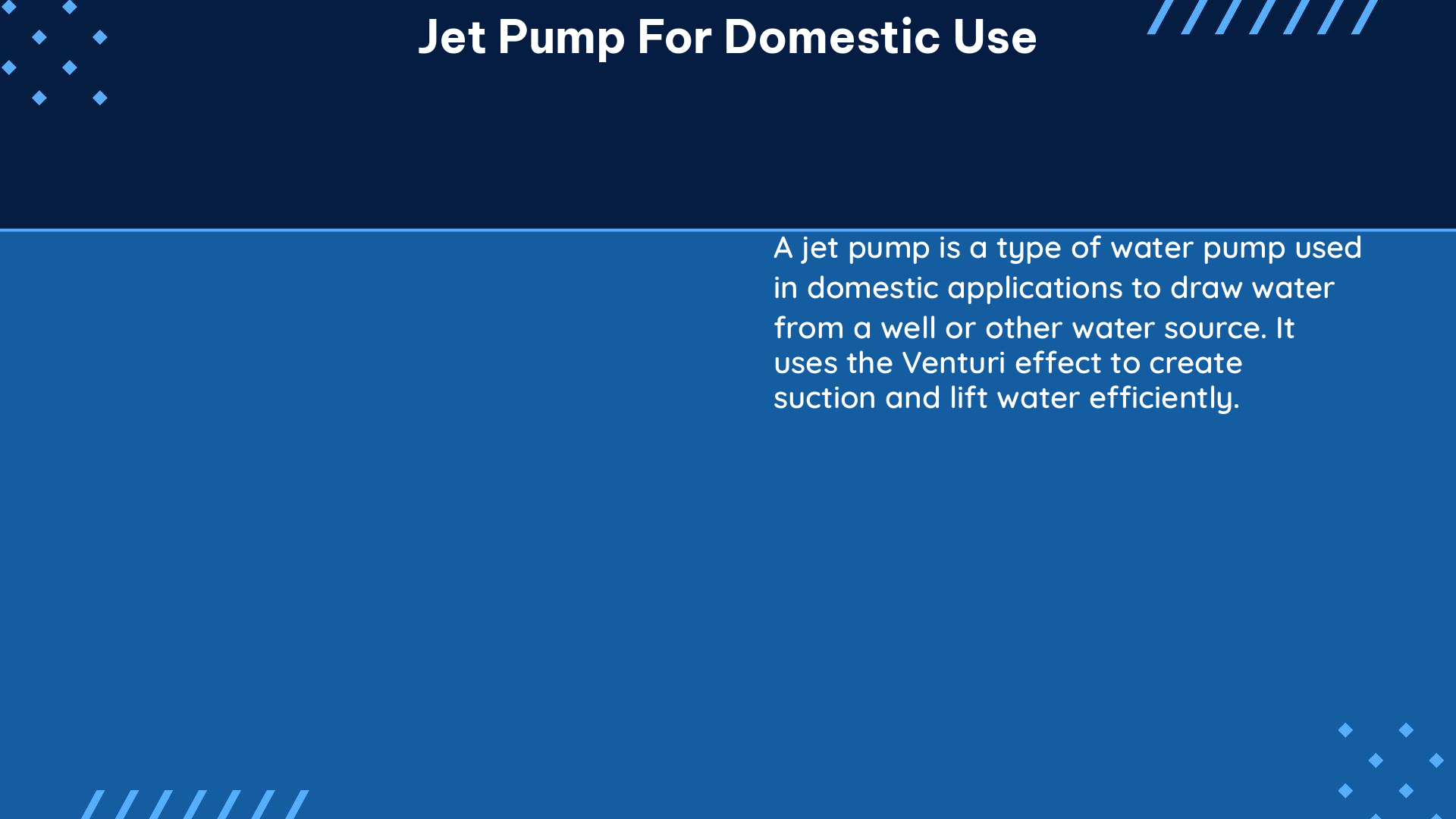Jet pumps are a popular choice for domestic water supply, particularly in areas with wells or other water sources that require a reliable and efficient pumping system. These centrifugal pumps utilize the Venturi effect to create a pressure difference, allowing them to draw water from the source and deliver it to your home. In this comprehensive guide, we’ll delve into the technical specifications, installation, maintenance, and troubleshooting aspects of jet pumps for domestic use.
Technical Specifications of Jet Pumps for Domestic Use
Flow Rate
The flow rate of a jet pump is a crucial factor in determining its suitability for your domestic water needs. Typically, a jet pump for domestic use will have a flow rate ranging from 5 to 20 gallons per minute (GPM). The specific flow rate required will depend on the size of your household, the number of water-consuming appliances, and the desired water pressure.
Pressure
The pressure generated by a jet pump is another essential specification. Domestic jet pumps typically operate within a pressure range of 30 to 60 pounds per square inch (PSI). This pressure range is suitable for most household applications, such as supplying water to faucets, showers, and washing machines.
Power
Jet pumps for domestic use are commonly powered by electricity and have a power rating ranging from 1/2 to 2 horsepower (HP). The specific power requirement will depend on the size of the pump, the depth of the water source, and the desired flow rate and pressure.
Net Positive Suction Head Required (NPSHr)
The Net Positive Suction Head required (NPSHr) is the minimum suction head needed to prevent cavitation in the pump. For a jet pump used in a domestic setting, the NPSHr is typically around 5 to 10 feet.
Installing a Jet Pump for Domestic Use

Positioning the Pump
When installing a jet pump for domestic use, it’s crucial to position the pump at a level higher than the water source to prevent backflow. This ensures that the pump can effectively draw water from the source and maintain its prime.
Connecting the Power Source
Jet pumps for domestic use are typically powered by electricity, so you’ll need to connect the pump to a suitable power source. Ensure that the electrical connection is properly grounded and complies with local electrical codes.
Installing a Foot Valve
To prevent the pump from losing its prime, it’s essential to install a foot valve at the end of the suction pipe. The foot valve acts as a one-way valve, allowing water to flow into the pump but preventing it from flowing back out.
Maintaining a Jet Pump for Domestic Use
Checking the Impeller and Diffuser
Regularly inspect the impeller and diffuser of your jet pump for signs of wear or damage. These components are crucial for the pump’s performance, and replacing them when necessary can help ensure the longevity and efficiency of your system.
Cleaning the Venturi Tube
The venturi tube, which creates the pressure difference that draws water into the pump, can become blocked over time. Periodically clean the venturi tube to maintain the pump’s optimal performance.
Monitoring the Water Supply
Keep a close eye on the water supply to your jet pump. Ensure that the water source is not depleted or obstructed, as this can affect the pump’s ability to draw water and maintain its prime.
Troubleshooting a Jet Pump for Domestic Use
Checking the Power Supply
If your jet pump is not functioning correctly, the first step is to check the power supply. Ensure that the pump is receiving the appropriate voltage and that the electrical connections are secure.
Inspecting the Impeller, Diffuser, and Venturi Tube
Examine the impeller, diffuser, and venturi tube for any blockages or signs of wear. Clean or replace these components as needed to restore the pump’s performance.
Replacing the Pump
If the above troubleshooting steps do not resolve the issue, you may need to replace the entire jet pump. This may be necessary if the pump is beyond repair or if the water source has changed, requiring a different pump size or configuration.
By understanding the technical specifications, installation, maintenance, and troubleshooting of jet pumps for domestic use, you can ensure a reliable and efficient water supply for your home. Remember to consult with a professional if you have any doubts or concerns about the installation or operation of your jet pump.
References:
- Jet Pump NPSHr Data 4 – Eng-Tips. https://www.eng-tips.com/viewthread.cfm?qid=502163
- Efficiency of Jet Pumps | Request PDF – ResearchGate. https://www.researchgate.net/publication/245296825_Efficiency_of_Jet_Pumps
- Measurable Goals Guidance for Phase II Small MS4s – EPA. https://www3.epa.gov/npdes/pubs/measurablegoals.pdf

The lambdageeks.com Core SME Team is a group of experienced subject matter experts from diverse scientific and technical fields including Physics, Chemistry, Technology,Electronics & Electrical Engineering, Automotive, Mechanical Engineering. Our team collaborates to create high-quality, well-researched articles on a wide range of science and technology topics for the lambdageeks.com website.
All Our Senior SME are having more than 7 Years of experience in the respective fields . They are either Working Industry Professionals or assocaited With different Universities. Refer Our Authors Page to get to know About our Core SMEs.